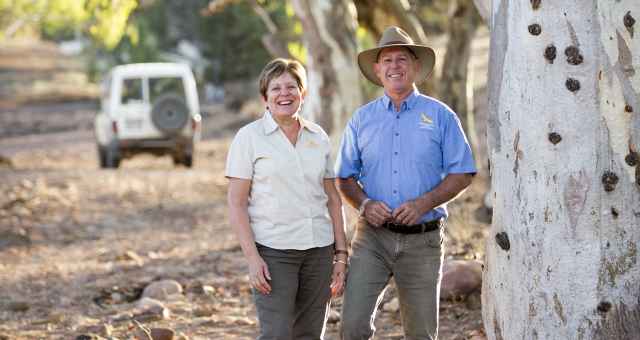HM correspondent, Graeme Willingham, has a kitchen conversation with Julie and Tony Smith, owners of Rawnsley Park, on the southern flank of Flinders Ranges’ Wilpena Pound.
In Tony and Julie Smith’s home kitchen, next door to Reception, the owners of award-winning Rawnsley Park Station say that after experiencing 10 years of dramatic growth — total revenue increased by an average rate of 11% pa — their tourism business is enjoying a “stable consolidation phase”, but plans are afoot for another round of “quiet expansion.”
Review of the property’s development timeline reveals that quiet expansion has been their modus operandi since they decided in 1968 to turn their 29,000 acre working sheep station into a tourism venture. The business started with six cabins and two shower blocks. Now, it has a restaurant, 25 units, eight up-market eco- villas, one equally stylish two-bedroom homestead with pool, a caravan park with 60 powered sites, shop and fuel, and numerous sites for unpowered or bush camping.
“We could, conceivably, accommodate some 400 to 500 people,” said Julie who starts this interview while Tony is still out on the station escorting a German film crew.
The 160-year-old station remains a working sheep farm, but tourism revenue has generated more income since 1983.
Eighty per cent of guests are from Australia with UK and Western Europe the biggest international markets. Occupancy rates are 80%-90% during Peak season (April/May and September/October) and 40%-50% Off season (summer months, driven by international visitors).
“Our development has been steady, conservative and planned in detail,” said Julie. “For instance, it took us two years to finalise plans for our first eco-villas and that involved extensive consultation with South Australia Tourism Commission, our architects and between Tony and I. SATC’s environmental development guidelines were invaluable.“
It was Bill Spurr (formerly CEO of the South Australian Tourism Commission) who suggested Rawnsley Park needed stylish 4.5-star self-contained accommodation for the Europe market. In 2005, the watchful Smiths built just four stand-alone eco- villas. They were a hit. So, three years later, they built another four and a year after the homestead was launched. These generated the growth.
“We’re talking about adding more villas sometime over the next couple of years and at this stage we’re thinking about the best location,” said Julie. “They will be on a different site to the existing villas so the integrity of those eight will not be compromised.”
Also on the list for infrastructure is a swimming pool for the villas and expanding the restaurant, called The Woolshed. Diners are known to drive 30kms from Wilpena for a meal at the corrugated iron Woolshed. Lamb from the property is assured.
Mid-April, Rawnsley Park had just introduced a helicopter option to light aircraft and escorted 4WD sightseeing tours of Wilpena Pound and to other highlights of Flinders Ranges, like Arkaroola’s Ridge Top Tour, lunch at the Prairie Hotel and the Bunyeroo and Brachina gorges.
“We’re looking to develop and improve all aspects of whole business,” said Julie.
What about maintenance?
“We also keep an eye on maintenance and upgrading product wherever we can. Like, in the units, we’ve renovated bathrooms and upgraded the cladding but the change generating the most impact was Tony’s idea to add decks to all units. That made a huge difference to the user-friendliness of these units … guests spend a lot of time on the decks, relaxing and taking in the views, and, later, the stars.”
At this point, Tony arrived and joined in the kitchen chat.
“And we keep an eye on the condition of the walking-hiking tracks and bike trails around the property,” he said.
On the business side, Tony said total yield had remained relatively steady at around 15% of income, “despite our best efforts to improve it”.
The biggest cost is staffing which accounts for about 40% of total costs. Rawnsley Park has 12 directly-employed staff and a further 10 staff employed by the restaurant and caravan park. Two thirds of staff are full time.
“We’re expecting that with strong demand for Lake Eyre experiences this winter, there is a good chance we can maintain these employment levels through that traditionally quieter period,” he said.
Tony said he was buoyed by the business outlook for Rawnsley Park, and the Flinders Ranges tourism industry as a whole.
“Over the last 18 months, we are seeing the impact of a lower AUS Dollar helping to improve demand from both international and domestic visitation,“ he said.
“Another factor that seems to be helping visitation to the Flinders Ranges is an increased preparedness to travel in the hotter months. While I am the first to admit that summer is not the best time to travel here, most international visitors come to Australia in the Northern Hemisphere winter. Australians also seem to be travelling more in our warmer months, and with air-conditioned vehicles and air-conditioned accommodation, it can be a quite comfortable experience.
Tony said that while The Flinders Ranges were discovered for many people as a tourism destination 40-50 years ago when the National Park was proclaimed, facilities like Rawnsley, Wilpena, Prairie and Arkaba have broadened the customer base.
“The Flinders is still a magnificent, scenic destination for touring, adventure, hiking, 4WD, caravanning and camping, but now the area is better equipped for those travellers who seek another level of comfort, which can be easily accessed by the standard family car.
“That’s not to say everything is rosy here,” added Julie. “We have limited air access – the nearest airport is Port Augusta, 150 kms away – and as a remote location we have difficulty attracting staff, but the single biggest customer issue is lack of, or poor, internet access.”




